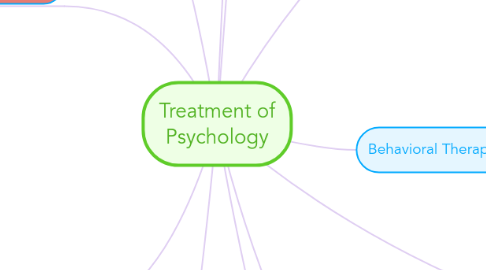
1. Earlier Beliefs
1.1. Deinstitutionalization
1.1.1. the process of replacing long-stay psychiatric hospitals with less isolated community mental health services for those diagnosed with a mental disorder or developmental disability.
1.2. Pine and Dix
1.2.1. Began treating the mentally ill with less severe procedures
1.3. Trephining
1.3.1. Make holes in brain to release bad spirits
2. Humanistic Therapies
2.1. Free Will
2.1.1. The belief that people are capable of controlling own desires
2.2. Gestalt
2.2.1. Exploring and bring all emotions up and attempting to bring them into a whole harmoneous body
2.3. Self-Actualize
2.3.1. To reach one's highest potential
2.4. Non-Directive
2.4.1. Clients essentially do all the work and try to figure out the root of there problem while the therapist does little work
2.5. Determinism
2.5.1. People have no influence over there own desires, opposite of free will
2.6. Existential
2.6.1. Attempting to give clients a reason to continue living, and give them a purpose in life
3. Somatic Therapies
3.1. Psychosurgery
3.1.1. Destruction of part of brain in order to fix a problem; however, this is very rare and has a low success rate
3.2. Psychopharmacology (chemotherapy)
3.2.1. Schizophrenia Treatments
3.2.1.1. Antipsychotics (Haldol or Therozine)
3.2.2. Anxiety Treatments
3.2.2.1. Barbiturates (Miltown) and Benzodiazepines (Xanax)
3.2.3. Unipolar Depression Treatments
3.2.3.1. Tricyclic antidepressants, monoamine oxidase inhibitors, serotonin reuptake inhibitor drugs
3.3. Electroconvulsive Therapy (ECT)
3.3.1. Unilateral (One Hemisphere)
3.3.2. Bilateral (Through Both Hemispheres)
4. Psychoanalytic Therapies
4.1. Symptom Substitution
4.1.1. an unconscious psychological process by which a repressed impulse is indirectly manifested through a particular symptom, anxiety, compulsion, depression, hallucination, obsession. Synonym(s): symptom formation.
4.2. Resistance
4.2.1. Patients disagree with methods of therapist
4.3. Dream Analysis
4.3.1. the analysis of dreams as a means of gaining access to the unconscious mind, typically involving free association.
4.4. Transference
4.4.1. the redirection to a substitute, usually a therapist, of emotions that were originally felt in childhood
4.5. Hypnosis
4.5.1. Patients are at an easy going state when in this method of treatment
4.6. Psychodynamic Theorists
4.6.1. therapy using the psychodynamic theory which is: view that explains personality in terms of conscious and unconscious forces, such as unconscious desires and beliefs.
4.7. Founder
4.7.1. Sigmund Freud
4.7.2. Free Associate
4.7.2.1. Saying whatever is on your mind without re thinking or processing your speech
5. Cognitive Therapies
5.1. Attribution Styles
5.1.1. Involve thinking that the person is a failure as external
5.2. Cognitive Theory
5.2.1. Engage the client in trials to try and better themselves and improve there quality of life, as well as trying to find the root of depression
6. Behavioral Therapies
6.1. Aversive Conditioning
6.1.1. Breaking a habit by using a unpleasant stimulus
6.2. Systematic Desensetization
6.2.1. Client replaces anxiety with relaxation
6.2.1.1. Anxiety Hierarchy
6.3. Modeling
6.3.1. Being exposed to others reacting to your phobia, and seeing there reactions
6.4. Flooding
6.4.1. Client brings up scariest idea first, which results in immense fear in patient which will hopefully extinguish.
6.5. Counter Conditioning
6.5.1. Unpleasant conditioned response is replaced with pleasant response
6.6. Operant Conditioning
6.6.1. Created by B.F Skinner
7. Group Therapy
7.1. Family Therapy
7.1.1. Counseling that involves the whole family in order to extinguish problems in the family
7.2. Self Help Groups
7.2.1. groups of people who provide mutual support for each other. In a self-help group, the members share a common problem, often a common disease or addiction
8. Prevention Methods
8.1. Primary Prevention
8.1.1. The attempt to reduce societal problems; for example: homelessness and poverty
8.2. Secondary Prevention
8.2.1. Work with at-risk people to prevent them from possible problems
8.3. Tertiary Prevention
8.3.1. Attempt to keep people's mental health issues at bay
9. Cognitive Behavioral Therapy
9.1. Rational Emotive Behavior Therapy (REBT)
9.1.1. A comprehensive, active-directive, psychotherapy which focuses on resolving emotional and behavioral problems and disturbances and enabling people to lead happier and more fulfilling lives.
10. Different Types of Therapists
10.1. Psychiatrists
10.1.1. specializes in the diagnosis and treatment of mental illness
10.2. Psychoanalysis
10.2.1. aims to treat mental disorders by investigating the interaction of conscious and unconscious elements in the mind and bringing repressed fears and conflicts into the conscious mind by techniques such as dream interpretation and free association.
10.3. Counseling Therapists
10.3.1. process of meeting with a therapist to resolve problematic behaviors, beliefs, feelings, relationship issues, and/or somatic responses (sensations in the body)
10.4. Clinical Psychologists
10.4.1. assessment and treatment of mental illness and disability.
